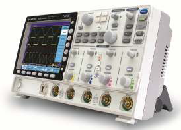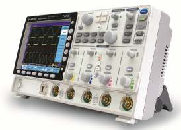Instek Self-Developed Waveform Image Processing System
GW Instek GDS-3000 Series digital storage oscilloscopes are equipped with a built-in self-developed waveform image processing system which significantly enhances the waveform capture rate. We call this VPO (Visual Persistence Oscilloscope) Technology.
![]() The first generation of analog oscilloscopes utilized fluorescent materials to capture fast electronic signals to generate a dot on a screen. By controlling the intensity and bias of an electron beam, the brightness and tracking of a signal could be generated. This was used to reconstruct a waveform image that would be displayed on a screen for a short time. For this reason, one can observe the details of a signal while the signal is changing with the naked eye.
The first generation of analog oscilloscopes utilized fluorescent materials to capture fast electronic signals to generate a dot on a screen. By controlling the intensity and bias of an electron beam, the brightness and tracking of a signal could be generated. This was used to reconstruct a waveform image that would be displayed on a screen for a short time. For this reason, one can observe the details of a signal while the signal is changing with the naked eye.
Digital storage oscilloscopes, usually viewed as 2nd generation oscilloscopes mainly convert analog signals into digital signals through high-speed analog to digital converters (ADC). These signals are then stored in its memory for the CPU to process and draw the waveform. The design of a DSO puts some of its functions far beyond the reach of analog oscilloscopes. For example: waveform storage, math operations (Example: – * / FFT), automatic measurements and pre-triggers. The only reason why analog oscilloscopes still fascinate so many people is because of their ability to display a signal in real-time.
Conversely, this is also the greatest disadvantage of digital storage oscilloscopes. As the CPU in a DSO does not have the processing power to process a waveform as fast as the signal is changing, only part of the signal is captured and processed. The section of time for when a signal is not captured is called Dead Time. The longer the dead time is, the greater the chance of not detecting a rapid change in the signal. If a DSO cannot detect such signals then it is unable to meet the demands of a modern measurement instrument.
The waveform image processing system designed and developed by GW Instek are mainly used to share the data processing with the CPU, shortening the time needed to draw a waveform and consequently increasing the waveform capture rate.
Furthermore, in order to create a display performance similar to that of analog oscilloscopes, the waveform data for all channels is displayed as a three dimensional image (amplitude, time and intensity). When a strong signal is generated, the waveform will be brighter and the waveform will persist for a longer time, allowing users to easily grasp any instantaneous changes in the waveform. By using an image processing system, waveform data can be quickly acquired by the DSO, processed and displayed on the screen with multiple levels of intensity almost as quickly as an analog oscilloscope.
Instek GDS-3000 Oscilloscope VPO Technology Video
By using VPO technology and a 5 GSa/sec sampling rate, the GDS-3000 Series significantly enhances waveform capture rate, allowing users to clearly observe video signals, DVD signals, and FM signals.

GDS3354 350MHz, 4 Channel , Visual Persistence Digital Storage Oscilloscope

GDS3154 150MHz, 4 Channel , Visual Persistence Digital Storage Oscilloscope
Latest posts by Mike Novello (see all)
- Used Bio-Rad Gel Doc XR For Sale - March 9, 2022
- CONSULTIX WTX-35-A4 CW Test Kit For Sale - November 9, 2021
- Biologic SP-150 Single Channel Potentiostat and VMP3B-80 Booster For Sale - September 7, 2021










